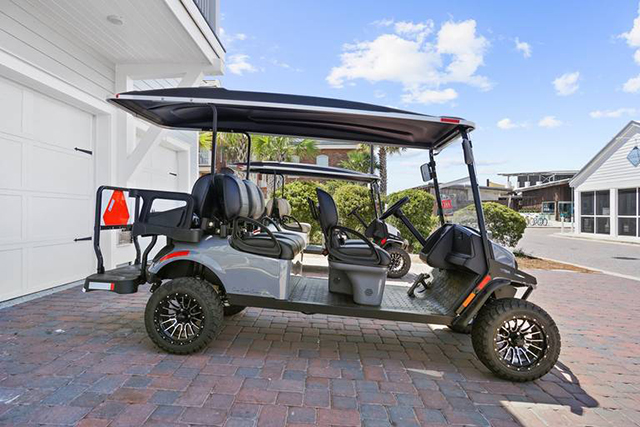While we refer to Low Speed Vehicles (LSV) as golf carts when we talk about them, they are different vehicles altogether. LSVs are sporty little vehicles and somewhat of an unofficial beach vacation car. But in actuality, they aren't the kind of carts you see on a typical golf course.
The difference between a golf cart and a low speed vehicle (LSV)
Golf carts are electric vehicles used to carry golfers and their equipment through 18 holes of a golf course. Golf carts have a dedicated purpose and are never permitted on any roadway at any time.
LSVs are considered legitimate motor vehicles, meaning they are street legal. LSVs have all the primary components of typical road-worthy cars and trucks, including a license plate, registration, seat belts, turn signals, brake lights, reflectors, headlights, mirrors and a D.O.T. windshield.
Due to the casual nature of LSVs, there can be a tendency to be a little more lax when operating them, but the laws apply regardless of how far you may be driving. Particular attention should be paid to children’s safety. While it may seem easiest to have kids pile onto the back bench or sit on your lap, they must be fully secured while driving – as with other motor vehicles.
LOW SPEED VEHICLE REQUIREMENTS
- LSVs must have the following equipment: Headlights, taillights, brake lights, seat belts for each designated seat, front and rear turn signals, horn, an AS1 or AS4 windshield, windshield wipers, side and rear mirrors, parking brake, side and rear reflectors, a lighted license plate, slow-moving vehicle emblem, and VIN.
- Must be able to reach 20 MPH but not greater than 25 MPH
- Must have a valid registration (tag) attached to the vehicle
There are penalties for not adhering to these Florida laws regarding LSVs, including hefty fines for each infraction and having the LSV towed and impounded.
LAWS FOR ALL DRIVER AND PASSENGERS OF LSVs
- Drivers must have a valid driver’s license.
- All front-seat passengers of any age must wear a seat belt.
- All persons under the age of 18 must wear a seat belt.
- All children aged 5 and under must be in a car seat or booster seat.
- No more than the maximum designated number of passengers are allowed.
LOW SPEED VEHICLE ROADWAY LAWS
- Low-speed vehicles may only be driven on roadways with speed limits of 35 MPH or less.
- It is illegal to drive low-speed vehicles on any sidewalk or bike path.
- It is illegal to drive low-speed vehicles on US Highway 98 or along the sidewalk along US Highway 98.
- Crossing US Highway 98 is only permitted at a four-way intersection.
- There are several LSV pullover spots along Hwy 30A that allow LSVs to pull off the road safely and let cars pass them. Drivers of LSVs are encouraged to pull over and let cars pass.
LSVs must follow all posted parking regulations
Specific laws apply even when you’re not driving. While LSVs have the advantage of being more compact and maneuverable than the average car, that doesn’t mean they can be left wherever they fit. LSVs can only be parked in spots designated for other motor vehicles. This excludes parking in front of driveways, on private property or in any marked No Parking zones. Whether you own the LSV or are renting, you’ll be responsible for any fines incurred.
- LSVs are not allowed in Rosemary Beach or Alys Beach. They will be towed immediately if they are found in either of these communities. Seaside allows LSVs in the merchant/dining areas but not on private streets.
For guests traveling to the beach, we don't recommend using an LSV as your primary source of transportation. There are many limitations of the vehicle such as the distance it will and won't travel, battery running out in the middle of a trip, nighttime driving on roads can be treacherous, and if the cart breaks down, there most likely will not be a loaner vehicle available for you. Guests are expected to have an automobile form of transportation in addition to the LSV.
Please keep in mind that these laws are designed for the public safety and to keep you and your loved ones safe. It’s best to know all the rules before you head out in your LSV during your stay on 30A. You can find a full list of LSV laws on the Walton County Sheriff’s website.

